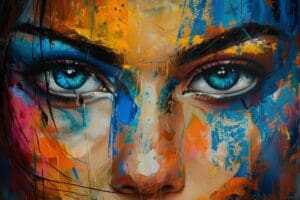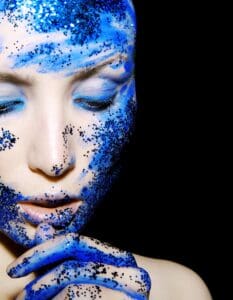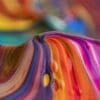Technique
Imagine manipulating very shallow pools of colored liquid paint. Place these colored pools on a flat rigid surface, then move the surface by tilting, shaking, tapping, or using a combination of these actions. Experiment with the pools on thought-out backgrounds, or let everything happen at once. Also propel colored liquids through the air, and (when motivated) add formal shapes later. The only guiding rule here is to discover what feels interesting, beautiful or pleasing, knowing already that designs are predetermined in the molecules, geometry and mechanics of fluid flow.
This is “fluidism”–an intense and exciting physical process that produces a particular style of painting. Fluidism is on-the-edge creativity where fascinating aspects of reality are born unexpectedly. In this style of art, calculation cooperates with chance. Wild actions combine with refined actions. Chaos cooperates with control to produce unpredictable, one-of-a-kind compositions.
Action Painting
This style of painting compares to the artistic style of Jackson Pollock (1912-1956), the famous American painter who helped popularize a technique called “action painting” during the 1940’s and 1960″s. Fluidism, however, does not aim to mimic, honor or aspire to a predefined idea of “action painting”. Instead, this style of action painting has arisen because of principles, motivations and circumstances originally not officially connected to a historical movement.
Artistic Physics
Fluidism, although an art style, is more related to the physics of fluid flow. Rather than appealing to abstract, expressive emotional states of the artist, this style of art reveals the fundamental fluid dynamic nature of the universe. This fundamental, ever-changing nature of the universe registers as emotion, after the art appears through spontaneous events. Here the realization of art causes emotions, not the other way around, where emotions cause the realization of art.
The truth is that the universe finds expressions through an artist, rather than an artist intentionally expressing his or her own impressions of the universe. In other words, the artist does not “own” his or her impressions. Rather, the dynamics of reality allow expressions unavoidably, through the motion of physical media that reflect the most primal creative principle of all. Fluidism, thus, is a direct expression of a primal creative principle. It is the primal principle’s “voice” via the artist. This creative principle expresses itself.
Self-Similar World-View
An artist manipulating fluid paint reflects nature manipulating itself into inevitable self-similar structures. Think of it this way: If fluid paint could last through eons of evolution, then it could form the artist’s body as a complex structure. Given the particular chemical properties of paint, however, the artist sees only a raw early stage of the life genesis process. He or she sees curious primitive patterns that are precursor patterns of organic living forms.
In the chemical processes of life, a blob of liquid eventually might lead to a cell. A filament eventually might lead to a tail or leg, or arm. A vortex eventually might lead to a beating heart. All these primitive structures (blob, filament, and vortex) exist in fluid flow. All these primitive structures exist and move within the liquid human body, only now contained in more highly organized arrangements and in more complex relationships. A human body toying with fluid, thus, is a human body experimenting with the forms and forces of its own physical creation.
(c) 2011 Robert G. Kernodle





